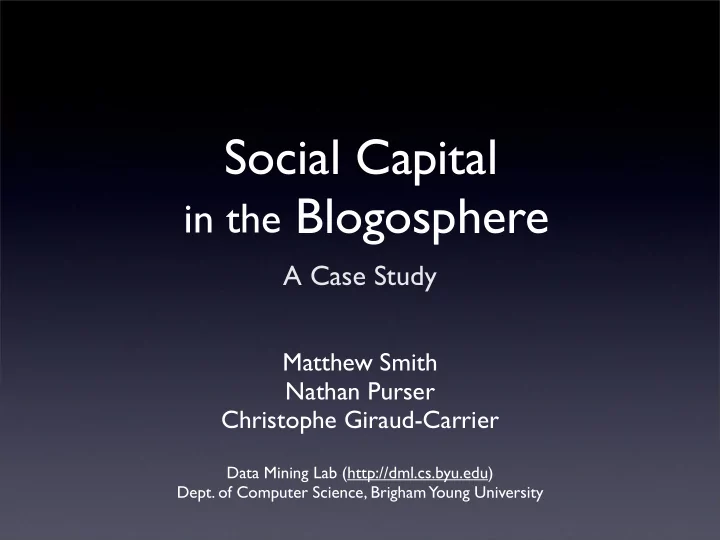

Social Capital in the Blogosphere A Case Study Matthew Smith Nathan Purser Christophe Giraud-Carrier Data Mining Lab (http://dml.cs.byu.edu) Dept. of Computer Science, Brigham Young University
Social Capital • Concept popularized by Robert Putnam ‣ Fosters reciprocity, coordination, collaboration, and communication ‣ Researched by many others including Burt, Lin, Coleman, and Bordieu ‣ Bonding and bridging • Social connections are beneficial ‣ Individual and group ‣ Ex. CEO Compensation, open source projects • How to measure?
The Blogosphere • Open community that anyone can join (e.g., Blogger, Wordpress, SixApart, your own setup) • One can blog about anything (e.g., fine cuisine, bluegrass music, CS research) • Both explicit and implicit connections (e.g., anchor links, interests) • Measurable (e.g., posts are time-stamped, clickstream available)
Types of Connections • Explicit Link ‣ Direct knowledge, interaction, or communication ‣ Ex. friends, web links, and club members ‣ Explicit Social Networks (ESNs) • Implicit Link ‣ Inherent similarities or affinities ‣ Ex. attributes, hobbies, interests, and background ‣ Implicit Affinity Networks (IANs)
ESN Explicit Social Network (ESN) Links: Friends, Web Links, etc.
IAN Implicit Affinity Network (IAN) Links: Affini4es or inherent similari4es
Hybrid Network ESN overlaid with IAN Applica4ons: Medical, Poli4cal, Blogosphere, etc.
Actual vs. Potential Social Capital • Potential Social Capital (IAN) • Actual Social Capital (ESN) ‣ Accrues only when explicit links are present
Bonding vs. Bridging Social Capital • Individual • Network
Blog Experiment • Focus ‣ Social capital largely unknown ‣ Communities centered around topics • Details ‣ Created blog database / Google Reader API ‣ 13 million blog entires ‣ 38,000+ blogs ‣ July 2006 - July 2007 (1 year)
Entry Retrieval Process • Began with Robert Scoble’s blog • Three step process 1. Use pyrfeed to access blog entries using the unofficial Google Reader API 2. Extract all links within blog entries 3. Follow all HTML links to other blogs
Criteria for Implicit Links • Topics ‣ Used first level of blog entries ‣ Latent Dirichlet Allocation (LDA) ‣ Ten topics were extracted (see next slide) • Implicitly linked by identical topic sets ‣ Topic membership assigned when entries contained an n -gram from the topic ‣ Identical topic sets
Topics
Criteria for Explicit Links • Explicitly linked by hyperlink references within blog entries • 30 reciprocal cross-references ‣ Narrowed number of blogs to 224 ‣ 2358 links, 494 explicit, 1864 implicit
Hybrid 5 Network S 4 1 6 2 3
Conclusions 1 of 2 • Bonding relationships exist ‣ Explicitly disconnected bloggers writing about the same topics were identified ‣ New sub-communities through bonding • Bridging relationships exist ‣ Actual bridging was shown ‣ Bridging opportunities were identified
Conclusions 2 of 2 • Methodology ‣ Actionable, applicable to online communities • Mathematical formulation of social capital ‣ Utilizes explicit (ESN) and implicit links (IAN) ‣ Bonding and bridging vary independently
Future Work • Affinity and social relationship strengths ‣ Which attributes should be used for affinities? ‣ What is a significant explicit relationship? • Further validate social capital metrics • Suggest potential connections to bloggers • Pinpoint bloggers with high social capital ‣ Adjust the filtering criteria ‣ Leverage the long tail
Questions & Comments Email me: Ask me now: ? Ma=hew Smith smi=y@byu.edu Connect: Web: h=p://dml.cs.byu.edu/~smi=y Blog: h=p://dmine.blogspot.com LinkedIn: h=p://linkedin.com/in/smi=y
Recommend
More recommend